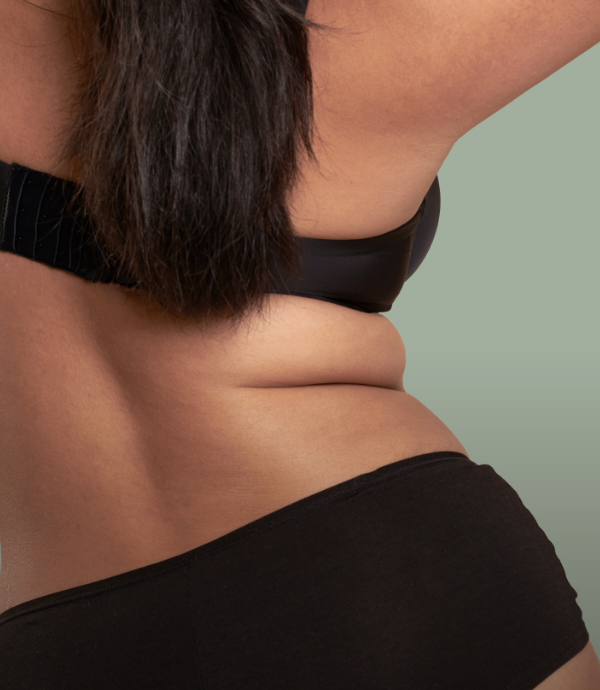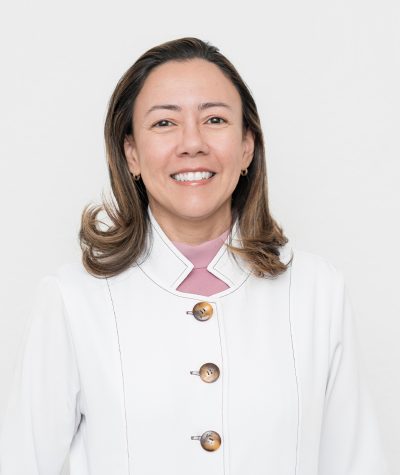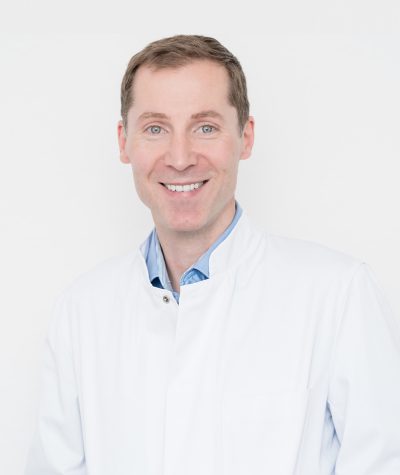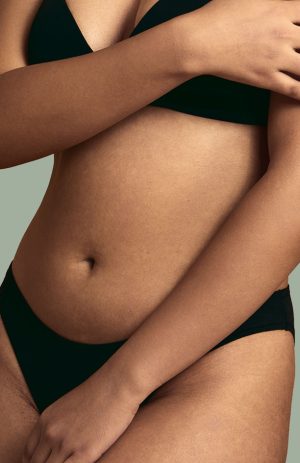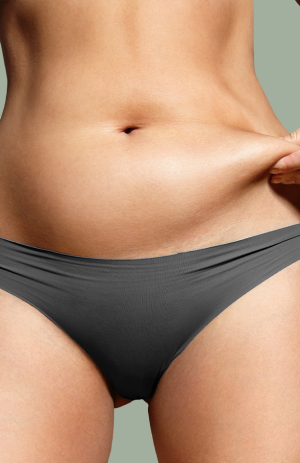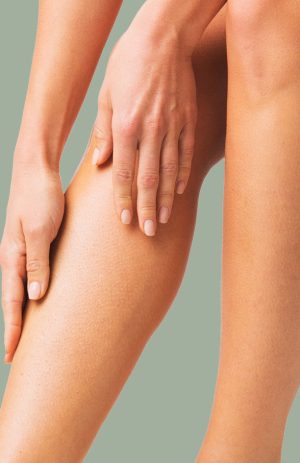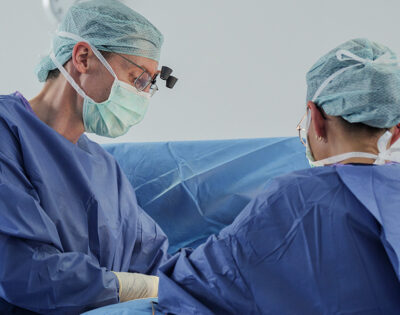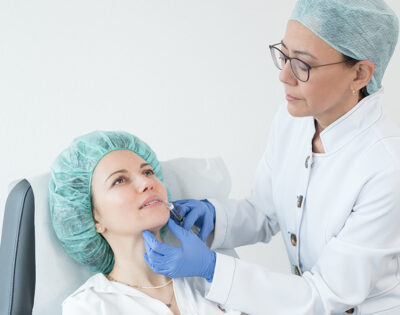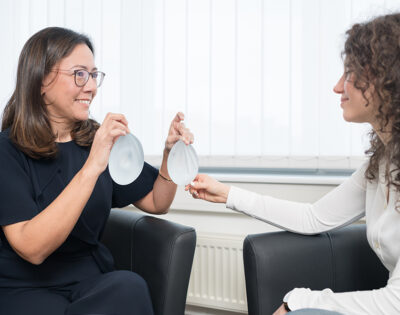Liposuction in Saarbrücken
During professional liposuction, fat deposits are suctioned out with fine microcannulas and thus permanently removed. In this way, problem areas where fat pads protrude can be adapted to the rest of the body contours.
With a liposculpture, certain lines and contours (e.g. Venus dimples, champagne groove) can be specifically emphasized. With tiny incisions that can be hidden in the fold lines of the skin or under a swimsuit, targeted, lasting and visible contour improvements can be achieved. First, fluid is injected into the subcutaneous tissue to loosen the tissue. The excess fatty tissue is then gently removed using a cannula and a vacuum pump.
What our patients say
Information at a glance
Operation duration
1 hour
Aftercare
6 weeks
Anesthesia
Twilight sleep
Thread tension
after 10-14 days
Hospitalization
Outpatient
Socially acceptable
after 5-7 days
Costs
Additions or alternatives
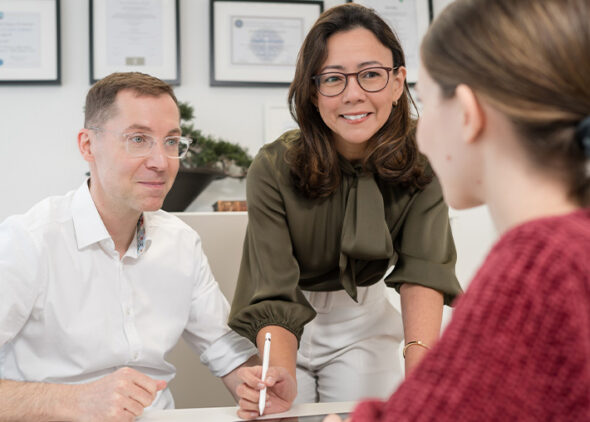
What experience do the CenterPlast specialists have with liposuction?
The surgeons at CenterPlast are highly trained specialists in plastic and aesthetic surgery. Dr. Santos Stahl and Privatdozent Dr. Stahl have passed the German and European specialist examinations. Dr. Santos Stahl completed her specialist training in Brazil. The country is considered a pioneer in the field of aesthetic surgery. Privatdozent Dr. Stahl is a former clinic director in a maximum care hospital. The specialists are characterized by their many years of experience, their commitment to the safety of their patients and the development of innovative techniques. They have experience as senior doctors, train other doctors and are networked with leading plastic surgeons in Europe, the USA and Brazil.
Every single step on the way to the goal is crucial for the best possible result. The CenterPlast specialists take all necessary precautions to avoid unexpected complications. If unavoidable complications arise, the surgeons know what to do. Thanks to many years of experience with a variety of techniques (lifting operations, autologous fat treatments, minimally invasive treatment methods, microsurgery), the surgeons can also treat complications following liposuction. CenterPlast has the latest technology at its disposal. Modern procedures are used to prevent pain. Every procedure is carried out according to the strictest hygienic standards.
Liposuction procedure

Preparation
The procedure on the day of the operation will be explained to you step by step during the consultation. On the day of the operation, you will be received personally by your surgeon. The areas of the body to be treated are precisely marked in consultation with you. The drawing resembles the contour lines on a map. You will be fitted with compression stockings and taken to the operating room. Here we make sure that you lie as comfortably as possible. For your safety and comfort, the operating table has a special state-of-the-art foam core.
If you wish, you can listen to music to relax. A special warm air flow ensures that you are pleasantly warm. In accordance with the highest safety standards, the entire team discusses the treatment plan on the basis of a checklist. If you wish, you will be given medication to help you relax. The surgical field is then disinfected with an alcohol solution and protected with sterile drapes. The anesthetic is carefully injected into the tissue using small cannulas. After the anesthetic solution has had its maximum effect, the fatty tissue is released using the SAFELipo technique. If you are not sleeping peacefully anyway, you may notice the surgeon’s hand movements.
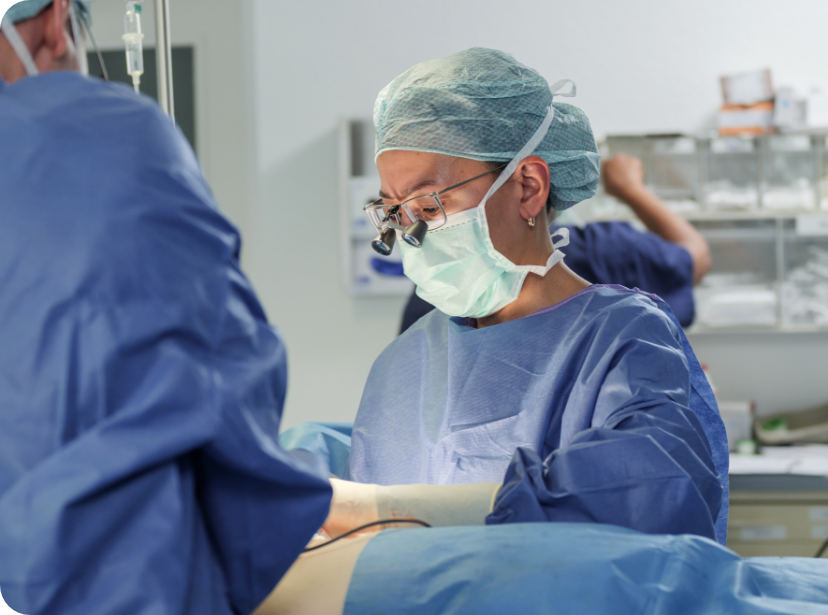
The OP
The fat deposits are thinned out using fine cannulas. During the operation, the surgeon feels the skin with great sensitivity and care. Every step is precisely documented. The small punctures are finally stitched and connected with fine skin threads. You will then be fitted with compression underwear. The procedure takes about 1.5 to three hours, depending on the findings. You can then rest while your vital signs are monitored for a few more hours. If you feel like it, you can also have something to drink or eat.
Before you are collected by your relatives, you will be given a report. It clearly explains all the steps of the operation and what to do after the operation. Appointments will be made to check your well-being and recovery. In the report you will also find the personal cell phone number of the surgeon, who is always available for you. By the way, before, after and even during the operation you can watch movies or your favorite series with virtual reality glasses. This is not only entertaining, the distraction has also been proven to reduce sensitivity to pain.
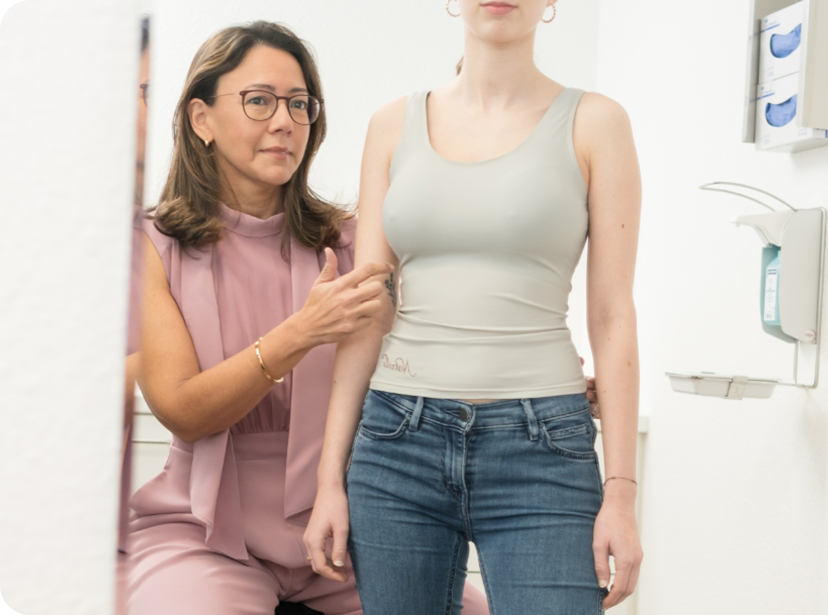
After the procedure
- Postoperative medical checks usually begin on the 3rd postoperative day. The next check-up appointments take place after 1, 2, 6 weeks and after 6 & 12 months.
- The stitches are removed between the 10th and 14th day after the operation.
- Compression girdles that have previously been fitted to your body must be worn continuously for 6 weeks.
- Scar care in the form of scar massages, sun protection and silicone pads from the 3rd postoperative week onwards support scar healing and help to make scars less noticeable.
- Sporting activities, saunas, swimming and heavy work & sunbathing are prohibited for at least one year. 6 weeks.
- Consistent sun protection (i.e. with sun protection factor 50+) for 6 months is recommended.
- More detailed information on aftercare can be found on the respective subpage of the specific treatment. We will of course explain all the points to you in a personal meeting and answer any questions you may have.
What are the risks of liposuction?
Liposuction is one of the most frequently performed procedures in plastic surgery, with over two hundred thousand procedures carried out every year. The operation is considered to be one of the safest, provided that specific safety measures are taken into account. Unfortunately, doctors without surgical training also offer liposuction without authorization. It is not uncommon for large amounts of fatty tissue to be suctioned out. As a result, media reports of serious complications are increasing. Only plastic surgeons learn the technique of liposuction in their further training. To avoid complications, the experts at CenterPlast:
- a team of trained specialists in plastic and aesthetic surgery with many years of experience
- Competent advice and selection of the appropriate treatment,
- Accompaniment and monitoring by highly experienced anesthesiologists,
- atraumatic surgical procedures in combination with a precise surgical technique.
The most common risk after liposuction is the appearance of dents. Dents are observed in two to three percent of cases. Legs of different lengths or crooked hips are common. People are often more aware of pre-existing side differences after liposuction. Liposuction is not suitable for correcting postural deformities. Irregularities can be corrected with fat injections six months after liposuction. The CenterPlast specialists take the following preventive measures to minimize the risk of irregularities:
- Suction is performed using the SAFELipo technique.
- Fine suction cannulas with a diameter of two to three millimeters are used.
- The thickness of the skin soft tissue mantle is constantly checked during the operation.
- The deep layers of fatty tissue are primarily thinned out.
- The suction cannulas are carefully guided with the opening of the cannula aligned with the tissue to be suctioned.
- The movements of the cannula tip are constantly monitored by subtly feeling the treated areas of the body during the operation.
- The tissue is suctioned in a “criss-cross” technique to avoid creating furrows.
- Suction is switched off when the cannula enters or exits the wound.
The aspiration of large amounts of fatty tissue, especially in the region of the lower abdomen, can lead to the accumulation of wound fluid (seroma). This can be treated by a puncture under ultrasound control. The risk of this is increased in patients with a high BMI and with ultrasound-assisted liposuction. Wound fluid can accumulate on the abdomen during the first week or three to four weeks after liposuction.
The CenterPlast specialists prevent the accumulation of wound water by taking the following measures:
- We recommend moderate liposuction in the area of the lower abdomen.
- We use the SAFELipo technique.
- We make sure that excess wound water can escape naturally through the wounds.
- We provide you with special compression underwear.
- We encourage you to engage in moderate physical activity immediately after the operation.
Liposuction can result in a dark discoloration of the skin. This may be caused by bleeding into the skin, sunbathing after liposuction or certain medications such as iron supplements or hormone preparations. In rare cases, skin necrosis may occur. Patients with connective tissue diseases and heavy smokers are at risk. Scars on the abdomen or blood sugar disorders can increase these risks. With careful selection of the treatment method and a gentle surgical technique, these complications are unlikely. A furry feeling occasionally occurs after liposuction. In the vast majority of cases, the loss of sensation improves or disappears spontaneously after two to three months.
In principle, any injury to the skin is an entry point for bacteria. Certain circumstances can impair the body’s defenses and encourage germs to multiply. This applies, for example, to long-term cigarette smokers, older people and people with chronic illnesses. Inflammation after liposuction requires antibiotic treatment and, in rare cases, surgical removal of infected tissue. The CenterPlast specialists take a number of measures to keep the risk of inflammation as low as possible:
- On the morning of the operation, we recommend that our patients shower with a disinfectant soap.
- Before the operation, your skin will be thoroughly disinfected several times with an alcohol solution.
- We use local anesthetics that also have an antibacterial effect.
- Operations that take more than two hours are performed under a preventive one-time antibiotic administration.
- We use disposable cannulas for suctioning.
- We plan close monitoring of wound healing in order to recognize and treat any disruption to wound healing in good time.
When aspirating large amounts of fatty tissue, a relevant loss of blood cannot always be ruled out. The surgeons at CenterPlast therefore recommend checking whether anemia is present before liposuction. A gentle surgical procedure, SAFELipo and the use of tumescent solution reduce the risk of significant blood loss.
The probability of death with liposuction is around 0.02 percent [1] . This corresponds to the risk of a fatal car accident after 46,000 kilometers of driving [2] . The most common recognizable causes of death during liposuction include thrombosis, embolism, abdominal organ injury, fat embolism and cardiopulmonary failure.
The risk of thrombosis and embolism is greater when large amounts of fat are aspirated and in severely overweight patients. Other risk factors for thromboembolism are smoking (tobacco cigarettes, e-cigarettes), hormone replacement therapy and lying down all the time. Plastic surgeons take the following measures to minimize the risk:
- You will be examined for your individual risk of thrombosis and embolism (age, smoking, hormonal contraceptives).
- The surgeons will help you to create the best possible conditions for carrying out liposuction.
- We recommend liposuction under twilight sedation, which is associated with a lower risk of thrombosis.
- Specialists recommend the aspiration of a moderate amount of fatty tissue per procedure.
- You will be given compression stockings to prevent thrombosis during the first three weeks after liposuction.
- We encourage you to exercise on the day of the operation. You should walk shorter distances several times on the first day after the operation.
- Depending on your individual risk, you will be given an injection to prevent thrombosis.
- Long flights can promote thrombosis. We therefore advise against air travel for the first four weeks after the operation.
Liposuction without surgery
The effectiveness of the following 6 techniques cannot be compared with the effectiveness of liposuction.
It is limited to the fatty tissue immediately beneath the skin. These methods are explained in more detail in the following sections.
Liposuction versus cryolipolysis (CoolSculpting®)
The effect of cryolipolysis cannot be compared with liposuction. The effect of cryolipolysis is mainly felt in the superficial fatty tissue. To achieve a satisfactory result, several cryolipolysis treatments are required at intervals of two months. Liposuction can be used to reduce both deep and superficial fatty tissue. Liposuction can reduce fatty tissue considerably more than cryolipolysis.
Liposuction versus fat transfer injections
A fat-away injection cannot replace liposuction. Repeated treatment with a fat removal injection reduces the small surrounding fat deposits, such as a double chin, to a mild to moderate degree. With liposuction, however, it is estimated that 50 times the amount of fatty tissue can be removed per treatment. You can find out more about the syringe on the fat removal syringe page.
Liposuction versus electromagnetic impulses (Emsculpt®)
The effect of electromagnetic impulses cannot be compared with liposuction. Electrical and electromagnetic impulses cause muscle tension. The electromagnetic impulses penetrate deeper into the tissue and do not cause any pain. In addition, electromagnetic impulses release higher muscle forces than electrical impulses. The electromagnetic impulses cause intensive muscle training and fat burning. Rapidly changing magnetic fields generate an electrical impulse in the underlying tissue. The nerves thus trigger muscle tension. A high frequency of muscle tension leads to an increase in muscle size and strength as well as fat loss. A reduction in a muscle gap between the straight abdominal muscles (rectus diastasis) has also been demonstrated. A treatment lasts thirty minutes. Twenty thousand pulses are generated during one treatment. Four treatments at two-day intervals are recommended. The results are visible after four weeks. The treatment is then repeated every three to six months to maintain the results. This technology (high-intensity focused electromagnetic, HIFEM) was approved by the US Food and Drug Administration (FDA) in 2018 for the treatment of the buttocks and abdomen. The strength of the muscle tension can be adjusted from 0 to 100% with the Emsculpt® (BTL Industries, Inc., New York, NY, USA). The stronger the muscle contraction, the clearer the result. Most patients describe the treatment as pleasant. The only known complication is a temporary, slight muscle soreness. Electromagnetic pulses should not be used during pregnancy or in patients with metal implants or pacemakers.
Liposuction versus ultrasound (Liposonix®)
Ultrasound can be used to reduce fat (twenty kilohertz up to several gigahertz). Both the heat generated at 56 degrees Celsius and the cavitation primarily damage the fat cells. Cavitation refers to strong pressure fluctuations that cause the fat cells to burst. Ultrasound technology makes it possible to reduce the hip circumference by two to four centimeters. The penetration depth is one to three centimeters. The effect is therefore much less than the effect of liposuction. As a rule, at least three treatments at four-week intervals are required. A treatment of the abdomen, for example, takes about thirty minutes. The result is visible after two to six months.
Liposuction versus radiofrequency (Thermage®)
Radiofrequency devices primarily cause a slight tightening of the skin. In addition, radiofrequency devices can break down fatty tissue to a small extent. The radio frequency waves are delivered to the skin through electrodes and generate heat between 43 and 45 degrees Celsius. The increase in temperature leads to shrinkage of the tissue. The cells of the connective tissue (fibroblasts) are stimulated to produce collagen and elastic fibers. The warming of the tissue leads to a breakdown of the fat cells. To prevent burns, certain devices simultaneously cool the skin and continuously measure the temperature of the skin surface. A radiofrequency treatment takes twenty to thirty minutes. The heat development can lead to slight pain. The redness and swelling of the treated areas will improve after a day. Occasional side effects include hypersensitivity, a temporary sensation of pain, fat loss and nodule formation. Several treatments are required to achieve an improvement. The result can be observed after two to six months.
The most common radio frequency devices include
- Thermage® (Solta Medical, Pleasanton, California, USA). The device was approved by the US Food and Drug Administration (FDA) in 2002. The approved applications are skin tightening and fat reduction on the face, stomach, thighs and buttocks.
- Vanquish® (BTL Industries, Boston, Massachusetts, USA). The device is suitable for a small amount of fat loss on the stomach, back and flanks.
- truSculpt® (Cutera, Brisbane, California, USA).
- Venus Legacy® (Venus Concept, Toronto, Ontario, Canada). The device uses radio frequency and electromagnetic pulses.
Liposuction versus laser lipolysis (SculpSure®)
Laser lipolysis is a technique for reducing fat deposits on the abdomen, back, flanks and neck (double chin). There are two different methods of laser treatment. Low-level laser therapy (LLLT) with wavelengths from 532 to 635 nanometers. Low-level laser therapy makes the cell wall of the fat cells permeable. The fat cells thus release their fat reserves. The treatment lasts around thirty minutes and is repeated twice a week for six weeks. Hyperthermic laser treatment (hyperthermic laser lipolysis, HTLL) uses wavelengths of at least 1060 nanometers. The laser causes the temperature of the fatty tissue to rise to 42 to 47 degrees Celsius. The effect unfolds 0.5 to 2.5 centimeters below the skin. The fat cells die and are broken down by scavenger cells. Two to twelve treatments of twenty minutes each at six-week intervals are required. The laser devices cool the skin surface to prevent burns. Laser lipolysis can cause slight pain. Swelling and tissue hardening will disappear after a week. The treatment areas should be free of scars and tattoos. The following devices are used for laser lipolysis.
- SmartLipo® (manufactured by Deka, Italy, marketed by Cynosure, Westford, Massachusetts, USA). SmartLipo® uses a Neodymium:Yttrium-Aluminum-Garnet (Nd:YAG) laser (wavelength of 1064 nanometers, 1320 nanometers and 1440 nanometers). The device has been approved in the USA since 2006.
- SculpSure® (Cynosure, Westford, Massachusetts, USA). The device uses a wavelength of 1060 nanometers and has been approved by the US Food and Drug Administration (FDA).
- Erchonia Zerona® v2.0 (Erchonia1 LipoLaser; Erchonia Medical, Inc., McKinney, Texas, USA). The green laser has a wavelength of 532 nanometers.
- Fotona TightSculpting® (Fotona, LLC, Dallas, Texas, USA). The device is approved in the USA for fat reduction and skin tightening. Two lasers are used (1064 nanometer Nd:YAG and 2940 nanometer Er:YAG).
11 reasons to perform liposuction on an outpatient basis.
Outpatient surgery offers many advantages:
- Scientific studies show that outpatient surgery in twilight sleep with experienced plastic and aesthetic surgeons and experienced anesthetists is safe.
- Coordinating the date of the operation is straightforward.
- The excitement before an outpatient procedure is usually less.
- You are spared the cumbersome formalities and filling out long forms before being admitted as an inpatient.
- You don’t have to do without the comfort of your home.
- You will recover more quickly in your familiar surroundings. The healing process is often better.
- There is no risk of infection with germs.
- The strange and anonymous environment of a clinic can be dispensed with.
- Clinics are often geared towards performing operations under general anesthesia. The experience with less stressful anesthesia is greater in outpatient centers.
- With outpatient surgery, you can expect all-round care from your trusted and experienced specialist in plastic and aesthetic surgery. Postoperative care is provided by your surgeon. Treatment from a single source improves quality and gives you peace of mind.
- Outpatient care strengthens the doctor-patient relationship of trust. This gives you a feeling of security and contributes to the success of the treatment.
What are the different methods of liposuction?
The technique of liposuction with negative pressure, which was already used in 1976, is known as “suction-assisted liposuction” (SAL). In this technique, the fatty tissue is removed using a hollow needle. The hollow needle has a blunt tip and lateral openings through which the fatty tissue is suctioned out at a negative pressure of 0.8 to 0.9 bar. The following techniques offer a complementary procedure to remove the cells from the tissue:
- Vibration liposuction (power-assisted liposuction, PAL).
- Liposuction with a water jet (water jet-assisted liposuction, WAL).
- Liposuction with ultrasound (ultrasound-assisted liposuction, UAL).
- Liposuction with laser (laser-assisted liposuction, LAL).
- Radiofrequency-assisted liposuction (RAL).
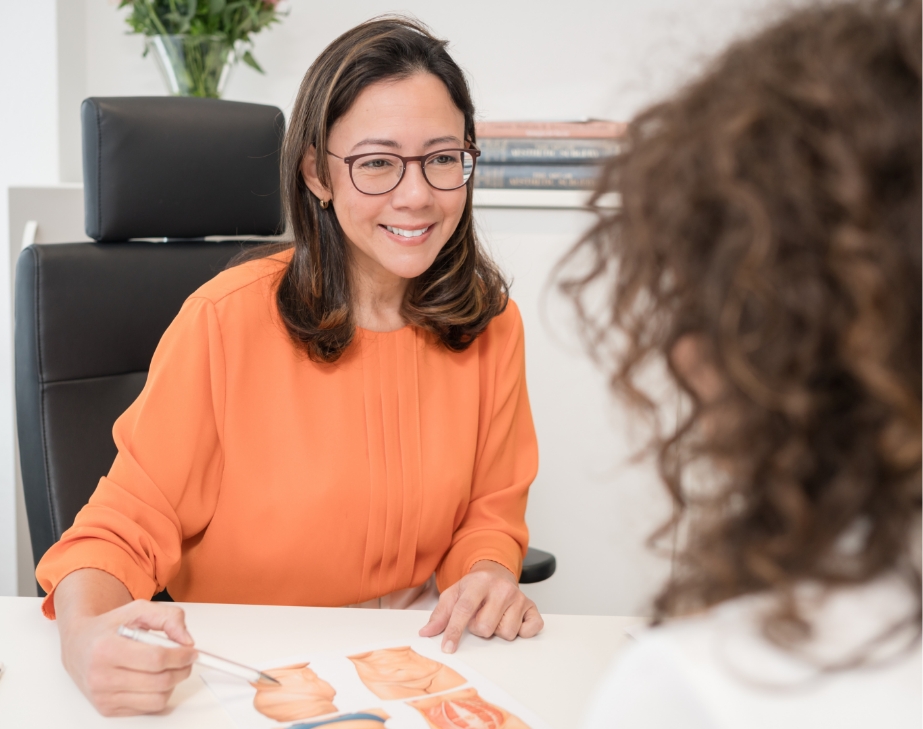
FAQ – Frequently asked questions
- The duration of the operation is approx. 1.5 to 3 hours, depending on the findings.
- Small areas can be treated on an outpatient basis and under local anesthesia or in twilight sleep.
- Larger amounts are removed under general anesthesia. Stationary monitoring for 1 to 2 days is then recommended.
- The small stitches are sewn with fine skin threads.
Liposuction of the abdomen is not covered by health insurance. Only in rare cases where there is a “pathological disfigurement” does an application for reimbursement of costs make sense.
Since January 2020, liposuction of the legs for stage III lipedema has been included in the benefits catalog of statutory health insurance. The admission is limited until December 31, 2024. Lipoedema is a pathological increase in fatty tissue, particularly on the legs and arms. The surgeons at CenterPlast have many years of experience in the treatment of lipedema. The specialists at CenterPlast are permitted to perform liposuction for stage III lipedema at the expense of statutory health insurance.
- Liposuction should be performed when you have reached your desired weight.
- All questions about possible complications & alternative treatments should have been answered in advance.
- Keep the consumption of nicotine and alcohol to a minimum!
- If necessary, adjust the temporarily stop taking hormone-containing medication (the pill).
- Blood-thinning medication (e.g. ASA, Thomapyrin®) must be discontinued at least 10 days before the operation (after consultation with your doctor).
- Vitamin preparations (A & E) and dietary supplements (omega-3 fatty acids / St. John’s wort preparations, etc.) must be taken at least once a week. 4 weeks before the plastic-aesthetic procedure.
- Follow-up cost insurance should be taken out before cosmetic surgery is carried out.
- Surgical procedures restrict your ability to travel by air. For this reason, do not plan any business or private air travel in the 6 weeks following the operation.
It is a misconception that a shower before wound healing is complete is dangerous. Wounds are normally covered with a dressing until the skin sutures are removed to protect them from moisture. A large number of studies have also shown that showering does not increase the risk of inflammation. Showering with tap water helps to clean a wound after an operation. Daily showers are very important for personal hygiene. Based on our many years of experience and scientific findings, we recommend showering with tap water on the 3rd day after the procedure, without soaking or rubbing the wounds. After showering, dry the wound(s) with a clean towel or with cool air from a hair dryer.
The surgeons at CenterPlast take numerous measures to prevent possible pain. All steps of the procedure are considered in order to make the procedure as comfortable as possible. The surgeons, the operating staff and the anesthetist will take care of your well-being. Even small details such as listening to music help you to relax. They are given pain-relieving medication. These also take away your fear.
The tissue is then gently injected with a long-acting local anesthetic. This ensures that you are not in pain even after the operation. As a preventive measure, you will be given well-tolerated pain medication such as paracetamol or ibuprofen. During the entire operation, you can put on virtual reality goggles and watch movies or your favorite series. In addition to entertainment, distraction has also been shown to help reduce sensitivity to pain. We will also provide you with the necessary pain medication to take home and after a week at the latest you will no longer need any pain medication.
The very fine cannulas for liposuction are inserted under the skin via 2 to 3 mm incisions. These incisions are made in the fold lines of the skin so that they are barely visible. The gentle, careful and atraumatic treatment of the tissue ensures particularly inconspicuous scar healing. The fine suture material creates a fine, line-shaped scar that is barely visible. An additional measure is to make the incisions on the right and left side of the body in different places so that even the tiniest scar does not give the impression of a planned operation.
The amount of fluid removed during liposuction consists of the removed body fat and the previously injected tumescent solution. The tumescent solution consists mainly of water and adrenaline and helps to minimize blood loss. Liposuction can remove up to eight percent of the body weight in fat volume per procedure (four to eight liters). The American Society of Plastic Surgeons defines five thousand milliliters as a large volume liposuction. There is no fact-based information on the maximum amount of fat that can be aspirated. In 2015, plastic surgeons from Chicago investigated the correlation between the amount of suction and the body mass index. They have found that minor complications (seromas) occur more frequently from a suction volume of one hundred milliliters per unit of body mass index. The risks of liposuction are lower in healthy patients. Obesity, diseases of the heart, lungs or metabolism, cigarette smoking and hormonal contraception are a health risk. These factors therefore also influence the risk of liposuction. How much fat can be suctioned out varies from patient to patient. The exact suction volume is determined during a personal consultation.
Liposuction of the abdomen, buttocks and legs is indeed possible in a single procedure. However, the total amount of fat tissue removed should always be moderate so as not to increase the risk of surgery. This upper limit naturally varies from patient to patient. The maximum amount depends on your state of health, your body weight and your lifestyle habits. In some individual cases, liposuction in several separate procedures is the safer way to achieve an optimal result. Whether this is the case will of course be clarified in a personal consultation.
CenterPlast uses several methods to prevent the occurrence of dents.
- The skin is marked before the operation for precise planning.
- The deep layers of fatty tissue are treated as a priority.
- The tissue is loosened with a so-called tumescent solution (super wet technique).
- The amount of tumescent solution used per area and side is precisely controlled.
- The tissue is loosened using the SAFELipo technique.
- Vibration liposuction helps to avoid unevenness.
- Fine cannulas are used to create even contours.
- Cannulas with openings that allow targeted treatment are mainly used.
- Liposuction is performed in a set standardized sequence.
- The amount of liposuctioned fat tissue is constantly monitored per area and side.
- The contours are constantly and subtly scanned during the procedure.
- Immediately after the operation, you will be put on a special compression garment.
The healing process can be accompanied by a hardening of the tissue. Two to three weeks after liposuction, tissue cells migrate into the treated regions. These cells form new collagen. The collagen is then gradually remodeled, realigned and cross-linked. During this remodeling phase, the tissue feels harder. If there is pronounced swelling and bruising after the procedure, the subsequent remodeling phase is correspondingly more intensive. To prevent hardening, it is therefore very important to wear compression underwear consistently, especially in the first three weeks. Manual lymphatic drainage and ultrasound treatments can also support healing. The operation itself can be ideally successful – the final result is only perfect after the follow-up treatment.
Swelling is unavoidable in the first few days after the operation. The special injected liquid (tumescent solution) is used to prevent bruising. Most of it is suctioned out during the procedure. A small proportion is taken up by the associations. The rest is excreted via the kidneys in the hours following liposuction. At the same time, various messenger substances increase the permeability of the blood vessels in the treated regions. This phase of wound healing lasts 1 to 2 weeks. The swelling then reduces considerably. The special compression underwear also serves to greatly reduce the swelling. If swelling is pronounced despite compression garments, early lymph drainage is necessary.
The compression underwear:
- reduces the unavoidable swelling after an operation.
- shortens the duration of the swelling.
- prevents the accumulation of wound water in the suctioned regions.
- promotes the shrinkage of the skin and helps to create a more beautiful contour.
- ensures that scars remain as fine and inconspicuous as possible.
High-quality studies show that compression stockings (anti-thrombosis stockings) reduce the risk of thrombosis after certain operations. The CenterPlast doctors recommend wearing compression underwear and compression stockings for three weeks after liposuction.
The results of liposuction become clearer with each passing day. The swelling can fluctuate throughout the day. The new body contours become more visible from week to week. The result is largely visible after approx. 4 weeks. The treated areas of the body may still feel a little hard at this stage and the surface of the skin may still be a little numb. The hardening of the skin and the feeling of furredness usually disappear completely in the 3rd month after treatment. Four months after the operation, the actual final result can be seen in around ninety-five percent of patients.
During a general anesthetic, your consciousness is temporarily switched off. The respiratory drive and protective reflexes are also completely suspended. Twilight sleep (also known as analgosedation) takes away your fear, reduces your sensitivity to pain and makes you sleepy. Twilight sleep offers many advantages:
- By combining different painkillers, the amount of stressful medication can be significantly reduced. They recover more quickly.
- Side effects such as nausea are much rarer.
- Serious side effects such as thromboses or embolisms are also rarer after twilight sleep than after general anesthesia.
- After a twilight sleep, you can return home more quickly and also eat and drink again more quickly.
- Patient satisfaction after twilight sleep is very high.
Tumescent anesthesia is a form of local anesthesia using a highly diluted anesthetic that is administered under the skin in large quantities. The technique was described by Matas as early as 1915 and later used by Klein for liposuction. In 1920 it was recognized that the addition of adrenaline is helpful. Adrenaline is a stress hormone that constricts the blood vessels when applied locally. This reduces the risk of bleeding. The anesthetic remains in the tissue for longer and the anesthesia lasts longer. The tumescent solution takes about twenty minutes to take effect. The use of a long-acting anesthetic ensures that you feel no pain even after the procedure. The amount of tumescent solution helps to keep blood loss to a minimum. The good tolerability and low risks as well as the excellent pain-relieving effect explain why the tumescent technique is also used for other procedures. The tumescent technique is also used at CenterPlast for tummy tucks, breast lifts, breast reductions, breast augmentations and face lifts. The advantages of the tumescent technique are
- You do not need general anesthesia.
- A sleeping pill is not absolutely necessary.
- Less medication enters the body’s circulation.
- Side effects such as nausea are unlikely.
- You recover more quickly and are back home more quickly after the operation.
Drains are not necessary for liposuction. If liposuction of the abdomen is combined with a tummy tuck, the short-term use of drains may be necessary in selected cases. In liposuction to correct a man’s breast in conjunction with the removal of a mammary gland, a drain is sometimes also used. Thanks to the use of a tumescent solution (injection of water with adrenaline) before liposuction, the use of blunt cannulas, careful preparation for the operation, good aftercare and a certain amount of sensitivity, there is no need to worry about post-operative bleeding. Patchy bleeding of the skin is unavoidable. The bruises will disappear on their own after five to ten days.
As early as 1964, the plastic surgeon Schrudde from Cologne removed fat deposits using a minimally invasive procedure. Schrudde drew marking lines on the skin to plan the operation and recommended wearing compression garments after the procedure. In 1976, Kesselring and Meyer developed the forerunners of today’s instruments: long hollow needles connected to a vacuum pump. In 1977, Parisian surgeon Illouz injected the tissue with an enzyme and a saline solution to reduce the risk of secondary bleeding.
In 1987, the Californian doctor Klein used the tumescent anesthesia technique described by Matas in 1915 for liposuction. The term is derived from the Latin and means “to swell”. The dilution of the anesthetic and the addition of adrenaline mean that only a small amount of anesthetic enters the body’s circulation. This means that a stressful general anesthetic can be dispensed with. Patients also recover more quickly after the procedure.
In 1990, Gasperoni also performed liposuction on the superficial layers of fat in order to correct contours more precisely. Matarasso first combined liposuction techniques with tummy tuck techniques in 1997 to perfect the results.
Vibratory liposuction was first approved by the US Food and Drug Administration (FDA) in 1998. With this method, a motor causes the hollow liposuction probe to vibrate. The hollow probe moves three millimeters back and forth up to four thousand times a minute. The fat tissue is loosened by the vibration. The fine vibration allows precise suction of fatty tissue. By aligning the openings in the hollow probe, the fatty tissue can be thinned out in a targeted manner. The amount of fat tissue suctioned off can be controlled by the vibration frequency. Unlike laser or ultrasound-assisted liposuction, there is no risk of burning. The risk of wound fluid accumulation is also lower than with ultrasound or laser-assisted liposuction. When treating the superficial fat layer, skin shrinkage is observed, similar to ultrasound or laser-assisted liposuction.
The SAFELipo technique is a special vibratory liposuction procedure that was described by the American plastic surgeon Wall in 2010. The technique is performed in three steps and reduces the risk of bruising and irregular contours. The acronym SAFE is made up of the English terms: “Separation”, “Aspiration” and “Fat Equalization”. After the injection, the fatty tissue is loosened using the vibration-assisted liposuction device and a special cannula. The fatty tissue is then suctioned out with three to four millimeter thin cannulas using vibratory liposuction. Finally, the contours are leveled with a special cannula. The SAFELipo technique is also used for autologous fat treatment. The technique offers many advantages and is therefore frequently used in the USA:
- Special cannulas stretch the tissue and enable even suction of the patient’s own fat.
- The vibration loosens the fatty tissue. This prevents dents and irregularities.
- The shape of the cannulas protects the blood vessels and reduces the risk of bruising.
- The cannulas are easy to guide, allowing precise and targeted correction of contours.
- Specially preformed cannulas increase the safety of the treatment.
The use of ultrasound for liposuction was first described by Scuderi in 1987. Ultrasounds are mechanical vibrations with a wave frequency above 16 kilohertz. During liposuction with ultrasound, the tip of the hollow probe is vibrated 19 to 27 thousand times per second. The vibrations cause pressure changes and a rise in temperature. Both lead to a liquefaction of the fatty tissue. Ultrasound-assisted liposuction is particularly effective for fibrous tissue. The superficial application of ultrasound waves and the increase in temperature leads to a slight shrinkage of the skin. There is evidence that ultrasound-assisted liposuction is gentler on the skin vessels than conventional liposuction (“suction-assisted liposuction”, SAL). However, the method has a significant disadvantage compared to the usual procedure. The ultrasound waves can cause burns and scarring. Newer third-generation ultrasound-assisted devices such as VASER® (Solta Medical, Hayward, CA, USA) therefore use pulsed ultrasound waves.
The use of water-jet assisted liposuction was first described in 2009. In this method, the liquid is injected over a wide area at an estimated pressure of 20 bar. The fatty tissue is then suctioned out as in the conventional suction-assisted liposuction (SAL) method. The Body-Jet® device required for this (Human Med, Schwerin) is mainly used in Germany. The fan-shaped injection at high pressure means that less tumescent solution is required.
Apfelberg first used laser-assisted liposuction in a study in 1991. The laser beam is emitted either before or during liposuction in the fatty tissue. Laser-assisted liposuction leads to a targeted increase in temperature in the fatty tissue. This destroys the fat cells, obliterates the smallest vessels and changes the structure of the collagen fiber bundles. Similar to ultrasound-assisted liposuction, the increase in temperature leads to a slight shrinkage of the skin. Laser-assisted liposuction therefore also carries a risk of burns. The combination of different wavelengths between 900 and 2800 nanometers is intended to improve skin shrinkage and reduce the risk of burns.
Several companies offer such devices as a supplement to liposuction:
- SlimLipo® (Palomar Medical Technologies GmbH, Hamburg) 924 and 975 nanometers.
- SmartLipo® (Cynosure Inc., Westford, MA, USA) 1064 and 1320 nanometers.
- ProLipo Plus® (Sciton, Palo Alto, CA, USA) 1064 and 1319 nanometers.
Radiofrequency surgery is a widely used surgical procedure. The terms high-frequency surgery, electrosurgery and diathermy are used synonymously. The process generates high-frequency electrical energy between two electrodes. The technology operates at frequencies of one megahertz and outputs of twenty-five to seventy-five watts. The electrical energy generates an increase in temperature. In radiofrequency-assisted liposuction, an electrode is inserted into the tissue. The other electrode is placed on the skin. The inner electrode is a hollow probe with a diameter of three millimeters. This hollow probe is insulated right down to the tip. The electrode on the skin surface is wider and absorbs the high-frequency current. Both electrodes are connected to a handpiece. The highest temperature is reached one centimeter around the tip of the hollow probe and the fat is liquefied. The liquefied fat is sucked out by the negative pressure in the hollow probe, as with conventional liposuction. The outer probe measures the temperature on the surface of the skin to prevent burns. On the skin surface, a temperature of 40°C to 42°C leads to the desired skin shrinkage and the formation of new collagen. The tissue is then further thinned using the conventional negative pressure method or vibratory liposuction. A device that is approved for performing radiofrequency-assisted liposuction is called BodyTite® (Invasix Ltd, Yokneam Ilit, Israel). BodyTite® received approval from the US Food and Drug Administration (FDA) in 2016.

AUTHOR
Dr. Stéphane Stahl
We provide you with extensive expert knowledge in order to select the best possible treatment path together with you.
Privatdozent Dr. med. Stéphane Stahl is the former Director of the Clinic for Plastic, Reconstructive and Aesthetic Surgery / Hand Surgery at Lüdenscheid Hospital. Dr. Stahl studied medicine at the Universities of Freiburg and Berlin.
He passed the European specialist examination for plastic and aesthetic surgery in 2011 and the German specialist examination in 2012. This was followed by further specialist qualifications and additional qualifications (including quality management, medical didactics, physical therapy, emergency medicine, laser protection officer, hand surgery) as well as prizes and awards.
In 2015, he completed his habilitation in plastic and aesthetic surgery in Tübingen. He is an experienced microsurgeon, sought-after expert witness and regular speaker at specialist congresses. Following a multi-stage selection process, Stéphane Stahl became a member of the American Society for Aesthetic Plastic Surgery (ASAPS), one of the world’s largest and most influential specialist societies for aesthetic surgery.
His authorship includes numerous articles in prestigious peer review journals and standard surgical textbooks.
You might also be interested in

Personal advice
We take time for you and offer you customized advice and treatment for your individual result.
